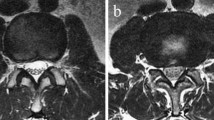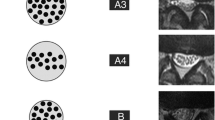Abstract
Purpose
Sedimentation sign was reported to have high sensitivity and specificity for diagnosis of lumbar spinal stenosis (LSS). We aimed to determine cerebrospinal fluid signal loss (CSFSL) at the intervertebral disc levels in the sagittal plane using a numerical scoring system and to evaluate the diagnostic value of this method in differential diagnosis of LSS and non-specific low back pain (LBP) and compare it with SS.
Materials and methods
We included consecutive patients between 50 and 80 years old, with lumbar spinal MRI examination in our institution. These patients were divided into two groups as LSS and LBP, according to symptoms and radiological findings. CSFSL sign was evaluated for both groups by two radiologists independently, using MR images. Sensitivity and specificity of both signs were calculated.
Results
A total of 406 patients (98 LSS and 308 non-specific LBP) were included. SS and CSFSL sign had a sensitivity of 90.8% and 82.7% and specificity of 75.4% and 84.1% in the whole cohort, respectively. When patients were grouped by dural sac cross-sectional areas (CSA), sensitivity and specificity of SS were 100% and 4.4%, 87.5% and 31.8%, and 41.7% and 76%, respectively, and sensitivity and specificity of CSFSL sign were 95.7% and 11.1%, 75% and 77.3%, and 16.7 and 92% for severe (CSA < 80 mm2), moderate (CSA: 80–100 mm2), mild (CSA: 100–120 mm2) radiologic stenosis, respectively. In moderate stenosis, accuracies of SS and CSFSL sign were 76.3% and 55.3%, respectively.
Conclusion
CSFSL sign might be used to distinguish LSS from LBP and unlike SS it is successful in moderate stenosis.







Similar content being viewed by others
References
Andreisek G, Imhof M, Wertli M et al (2013) A systematic review of semiquantitative and qualitative radiologic criteria for the diagnosis of lumbar spinal stenosis. Am J Roentgenol 201:W735–W746
Amundsen T, Weber H, Nordal HJ et al (2000) Lumbar spinal stenosis: conservative or surgical management? A prospective 10 year study. Spine 25:1424–1436
Boswell MV, Trescot AM, Datta S et al (2007) Interventional techniques: evidencebased practice guidelines in the management of chronic spinal pain. Pain Physician 10:7–111
Deer T, Sayed D, Michels J, Josephson Y, Li S, Calodney AK (2019) A review of lumbar spinal stenosis with intermittent neurogenic claudication: disease and diagnosis. Pain Med 20(Suppl 2):S32–S44
Steurer J, Roner S, Gnannt R, Hodler J (2011) Quantitative radiologic criteria for the diagnosis of lumbar spinal stenosis: a systematic literature review. BMC Musculoskelet Disord 28(12):175
Lurie JD, Tosteson AN, Tosteson TD et al (2008) Reliability of readings of magnetic resonance imaging features of lumbar spinal stenosis. Spine 33:1605–1610
Hamanashi C, Matukura N, Fujita M et al (1994) Cross-sectional area of the stenotic lumbar dural tube measured from the transverse views of magnetic resonance imaging. J Spinal Disord 7(5):388–393
Barz T, Melloh M, Staub LP et al (2010) Nerve root sedimentation sign: evaluation of a new radiological sign in lumbar spinal stenosis. Spine. 35:892–897
Wang D, Yang Q, Gao S, Ding L, Zhang Y (2013) The study of relationship between the nerve root sedimentation syndrome and lumbar spinal stenosis. Acta Univ Med Anhui 48:520–523
Resende VAC, Teixeira A, Silva JBD et al (2013) Lumbar spinal stenosis: sedimentation sign. Coluna/Columna 12:192–195
Zhang L, Chen R, Xie P, Zhang W, Yang Y, Rong L (2015) Diagnostic value of the nerve root sedimentation sign, a radiological sign using magnetic resonance imaging, for detecting lumbar spinal stenosis: a meta-analysis. Skeletal Radiol 44:519–527. https://doi.org/10.1007/s00256-014-2064-6
Zhang L, Chen R, Liu B, Zhang W, Zhu Y, Rong L (2017) The nerve root sedimentation sign for differential diagnosis of lumbar spinal stenosis: a retrospective, consecutive cohort study. Eur Spine J 26:2512–2519
Boden SD, Davis DO, Dina TS, Patronas NJ, Wiesel SW (1990) Abnormal magnetic-resonance scans of the lumbar spine in asymptomatic subjects. A prospective investigation. J Bone Joint Surg Am. 72(3):403–8
Verbiest H (1975) Pathomorphologic aspects of developmental lumbar stenosis. Orthop Clin North Am 6(1):177–196
Kim HJ, Lee KY, Kim WC, Oh YS (2011) Clinical value of nerve root sedimentation sign in lumbar spinal stenosis. J Korean Soc Spine Surg 18:117–122
Tomkins-Lane CC, Quint DJ, Gabriel S, Melloh M, Haig AJ (2013) Nerve root sedimentation sign for the diagnosis of lumbar spinal stenosis: reliability, sensitivity, and specificity. Spine 38:E1554–E1560
Laudato PA, Kulik G, Schizas C (2015) Relationship between sedimentation sign and morphological grade in symptomatic lumbar spinal stenosis. Eur Spine J 24(10):2264–2268
Hiraizumi Y, Transfeldt EE, Fujimaki E, Nakabayashi H, Ishikawa T, Sato H (1993) Electrophysiologic evaluation of intermittent sacral nerve dysfunction in lumbar spinal canal stenosis. Spine 18:1355–1360
Lentell GL, Katzman LL, Walters MR (1990) The relationship between muscle function and ankle stability. J Orthop Sports Phys Ther 11(12):605–611
Stucki G, Daltroy L, Liang MH et al (1996) Measurement properties of a self-administered outcome measure in lumbar spinal stenosis. Spine 21(7):796–803
Hashizume H, Konno S-i, Takeshita K et al (2015) Japanese orthopaedic association back pain evaluation questionnaire (JOABPEQ) as an outcome measure for patients with low back pain: reference values in healthy volunteers. J Orthop Sci 20(2):264–280
Watters WR, Baisden J, Gilbert TJ et al (2008) Degenerative lumbar spinal stenosis: an evidence-based clinical guideline for the diagnosis and treatment of degenerative lumbar spinal stenosis. Spine J 8:305–310
Sirvanci M, Bhatia M, Ganiyusufoglu KA et al (2008) Degenerative lumbar spinal stenosis: correlation with oswestry disability index and MR imaging. Eur Spine J 17(5):679–685
Fazal A, Yoo A, Bendo JA (2013) Does the presence of the nerve root sedimentation sign on MRI correlate with the operative level in patients undergoing posterior lumbar decompression for lumbar stenosis? Spine J 13:837–842
Funding
Funding for this study was met by authors.
Author information
Authors and Affiliations
Corresponding author
Ethics declarations
Conflict of interest
The authors declared no conflicts of interest.
Ethical approval
This is an original article. All procedures followed were in accordance with the ethical standards of the responsible committee and with the Declaration of Helsinki. Informed consent was not obtained from all patients to be included in the study since there were no retrospective studies. This retrospective study was approved by our institutional review board (Decision No: 2020/196).
Additional information
Publisher's Note
Springer Nature remains neutral with regard to jurisdictional claims in published maps and institutional affiliations.
Rights and permissions
About this article
Cite this article
Hızal, M., Özdemir, F., Kalaycıoğlu, O. et al. Cerebrospinal fluid signal loss sign: assessment of a new radiological sign in lumbar spinal stenosis. Eur Spine J 30, 3297–3306 (2021). https://doi.org/10.1007/s00586-021-06929-7
Received:
Accepted:
Published:
Issue Date:
DOI: https://doi.org/10.1007/s00586-021-06929-7




